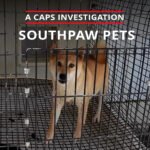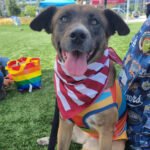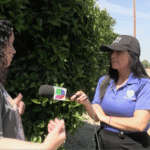Breeder: Burkhart, Joyce
Business name: Shady Valley Kennel
Address: 24268 Hwy 65
City, State Zip: Carrollton, MO 64633
Year: 2007
USDA License: 43-A-1261
Date of CAPS Investigation: 2007-10-31
Breeds: Pomeranian, Australian Shepherd, Shetland Sheepdog, Boxer, Beagle, Pit Bull, Chihuahua, Dachshund, Bichon Frise, Australian Cattle Dog, Cocker Spaniel, Maltese, Yorkshire Terrier, Shih Tzu, Pug, and Miniature Schnauzer.
BUILDING #1:
The facility consisted of one large shed-like structure which had a row of elevated kennels along the southern side. Approximately 20 dogs were housed in these cages visible from the outside.
There were indoor and outdoor portions that were connected via a small metal dog door. One cage even contained a litter of small puppies presumed to be less than 4 weeks of age. The outside door leading into the building was ajar at the time of the investigation and there were not any “no trespassing” signs present anywhere on the property. In search of owners of the facility, investigators pushed the door open further and called out to anyone on the property, but no one ever responded.
Inside the kennel were the indoor portions of the outdoor cages mentioned previously. These ran along the right-hand side of the building. On the left were rows of individual metal dog cages that housed dogs and puppies without access to the outdoors. These cages mostly contained young puppies between the ages of 2 weeks to 8 weeks of age. There was a strong smell of ammonia inside the kennel as there were no windows or fans to ventilate the unit (3.2(b)-Ventilation).
Most of the dogs had kibble in their bowls, but the majority did not have water. The bowls were all empty or turned upside in most of the cages (3.10-Watering). The dogs appeared to be housed in darkness (3.2)(c)-Lighting) as no light switches were ever found and the only light coming into the building seemed to be from the open door.
At the far end of the kennel building we came across several stacked dog carriers known as pet taxis. The majority of these carriers were empty, but the two on the bottom level housed one dog per carrier (3.6(a)-Primary enclosures).
In one such carrier, we noticed a severely emaciated white dog that did not move. Investigators attempted to wake the dog up, but when it didn’t move we opened the carrier and slid out the tray the dog was lying upon. The dog was very clearly dead. All of its rib bones were prominent and easily seen merely by looking at it. The smell was overwhelming and it was evident the dog had not died within the past few hours – it seemed to have been lying there for some time. The dog was so severely emaciated it was clear that it had starved to death and had not deteriorated to such a condition in a short period of time (3.9)(a)-Feeding).
OUTDOOR KENNELS:
Behind the residence and the initial kennel building were several small structures used to house the miniature Schnauzers, Shetland sheepdogs, Pit Bulls, Beagles, and Australian shepherds.
STRUCTURE #1:
One such structure was a pen with four fenced-in runs. The first two runs were approximately six feet long and 2 feet wide. One run housed a Pit Bull and the other housed a Beagle. The Pit Bull’s cage had one small, empty water dish (3.10-Watering). The other two runs in the structure were the same length but approximately 5 feet wide instead of 2. One such run housed four Australian Shepherds and the other housed a Boxer and another Pit Bull. The floor of this particular run had more than 24 hours of fecal accumulation strewn throughout the cement ground (3.11(a)-Cleaning of primary enclosures). The water in this pen was green with algae from not being changed on a regular basis (3.10-Watering).
STRUCTURE #2:
Another type of structure used to house dogs behind the residence was an elevated cage that stood approximately 2 feet above the ground and had wire flooring. It was approximately 4 feet deep, 2 feet wide, and 2 ½ feet tall. Two of these kennels were present on the property, but only one had dogs in it at the time of the investigation. This cage housed the Miniature Schnauzers.
In a fenced-in area beside the house, a large-breed dog was housed. The dog was very thin and investigators could not find any food supply available in his pen whatsoever. We provided a small Ziploc bag of dry kibble we had in the car to the dog and left a handful of dog treats which he ate immediately. He appeared to be very hungry and emaciated. This particular dog’s water supply consisted of a small kid-size plastic swimming pool that was filled with black and green water. It clearly had not been changed in several weeks, if not months, in order to fill with algae and turn such a color (3.10-Watering).
CAPS investigators reported this facility to CAPS President Deborah Howard, who then left a detailed message for Tim Ricky, Missouri Humane Society’s Director of Investigations. Mr. Ricky did not return Ms. Howard’s voice message. A Missouri Humane Society investigator called the investigators but didn’t seem to know anything about the information Ms. Howard had provided Mr. Ricky. She then said that she couldn’t use the information about the dead dog because the investigators had trespassed, which was not the case. Ms. Howard, an attorney, and CAPS pro bono attorney Randy Turner, discussed the matter. It was obvious to them that the Missouri Humane investigator did not understand trespass laws. It does not appear that the investigator went to the facility. This is not the first time that there has been a lack of cooperation from Missouri Humane, which has no police powers and must ask permission from kennel owners to inspect facilities. They can be useful, however, because they are more likely than CAPS to obtain cooperation from local law enforcement. CAPS is turning over the evidence to USDA.




